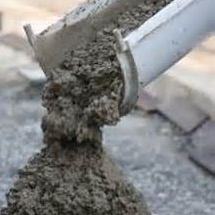
At its most basic form, concrete is composed of three main ingredients: cement, water, and aggregates.
In its simplest form, concrete is a mixture of paste and aggregates (i.e. sand & rock). The paste, composed of cement and water, coats the surface of the fine (sand) and coarse aggregates (rocks) and binds them together into a rock-like mass known as concrete.
Within this process lies the key to a remarkable trait of concrete: it is "plastic" and can be molded or formed into any shape when newly mixed, yet it is strong and durable when hardened. These qualities explain why one material, concrete, can build skyscrapers, bridges, sidewalks, and superhighways, houses and dams.
The key to achieving a strong, durable concrete rests on the careful proportioning and mixing of the ingredients. A concrete mixture that does not have enough paste to fill all the gaps between the rocks will be difficult to place and will produce rough, honeycombed surfaces and porous concrete. A mixture with an excess of cement paste will be easy to place and will produce a smooth surface; however, the resulting concrete will be more likely to crack.
A properly designed concrete mixture will possess the desired workability for the fresh concrete and the required durability and strength for the hardened concrete. Typically, a mix is by volume about 10 to 15% cement, 60 to 75% aggregates and 15 to 20% water. Trapped air bubbles in many concrete mixtures may also take up another 5 to 8%.
Portland cement's chemistry comes to life in the presence of water. Cement and water form a paste that surrounds and binds each particle of sand and stone. Through a chemical reaction of cement and water called hydration, the paste hardens and gains strength.
The character of concrete is determined by the quality of the paste.The strength of the paste, in turn, depends on the ratio of water to cement. The water-cement ratio is the weight of the mixing water divided by the weight of the cement. High-quality concrete is produced by lowering the water-cement ratio as much as possible without sacrificing the workability of fresh concrete. Generally, using less water produces a higher quality concrete provided the concrete is properly placed, consolidated and cured.
Besides portland cement, concrete may contain other "cementitious" (cement-like) materials including fly ash (a waste byproduct from coal burning electric power plants), slag cement (a byproduct of iron and steel manufacturing), and silica fume (a waste byproduct from the manufacture of silicon or ferro-silicon metal). Some of these cementitious materials are similar to the volcanic ashes the Romans mixed with lime to obtain their cement binder. Some of these structures still exist today! The concrete industry uses these materials, which would normally have to be disposed in landfill sites, to the advantage of concrete. The materials help in the hydration reaction and significantly improve the strength, permeability and durability of concrete.
Back to Homeowners


